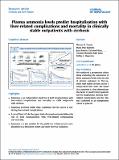Por favor, use este identificador para citar o enlazar a este item:
http://hdl.handle.net/10261/307153COMPARTIR / EXPORTAR:
 SHARE SHARE
 CORE
BASE CORE
BASE
|
|
| Visualizar otros formatos: MARC | Dublin Core | RDF | ORE | MODS | METS | DIDL | DATACITE | |

| Título: | Plasma ammonia levels predict hospitalisation with liver-related complications and mortality in clinically stable outpatients with cirrhosis |
Autor: | Tranah, Thomas H.; Ballester, María Pilar; Carbonell-Asins, Juan Antonio; Ampuero, Javier CSIC ORCID; Alexandrino, Gonçalo; Caracostea, Andra; Sánchez-Torrijos, Yolanda CSIC; Thomsen, Karen L.; Kerbert, Annarein J. C.; Capilla-Lozano, María; Romero-Gómez, Manuel CSIC ORCID CVN; Escudero, Desamparados; Montoliu, Carmina; Jalan, Rajiv; Shawcross, Debbie L. | Palabras clave: | Ammonia Ascites Bacterial infections Cirrhosis Hepatic encephalopathy Liver-related complications Variceal bleeding |
Fecha de publicación: | dic-2022 | Editor: | Elsevier BV European Association for the Study of the Liver |
Citación: | Journal of Hepatology 66(6): 1554-1563 (2022) | Resumen: | [Background & Aims] Hyperammonaemia is central in the pathogenesis of hepatic encephalopathy. It also has pleiotropic deleterious effects on several organ systems, such as immune function, sarcopenia, energy metabolism and portal hypertension. This study was performed to test the hypothesis that severity of hyperammonaemia is a risk factor for liver-related complications in clinically stable outpatients with cirrhosis. [Methods] We studied 754 clinically stable outpatients with cirrhosis from 3 independent liver units. Baseline ammonia levels were corrected to the upper limit of normal (AMM-ULN) for the reference laboratory. The primary endpoint was hospitalisation with liver-related complications (a composite endpoint of bacterial infection, variceal bleeding, overt hepatic encephalopathy, or new onset or worsening of ascites). Multivariable competing risk frailty analyses using fast unified random forests were performed to predict complications and mortality. External validation was carried out using prospective data from 130 patients with cirrhosis in an independent tertiary liver centre. [Results] Overall, 260 (35%) patients were hospitalised with liver-related complications. On multivariable analysis, AMM-ULN was an independent predictor of both liver-related complications (hazard ratio 2.13; 95% CI 1.89–2.40; p <0.001) and mortality (hazard ratio 1.45; 95% CI 1.20–1.76; p <0.001). The AUROC of AMM-ULN was 77.9% for 1-year liver-related complications, which is higher than traditional severity scores. Statistical differences in survival were found between high and low levels of AMM-ULN both for complications and mortality (p <0.001) using 1.4 as the optimal cut-off from the training set. AMM-ULN remained a key variable for the prediction of complications within the random forests model in the derivation cohort and upon external validation. [Conclusion] Ammonia is an independent predictor of hospitalisation with liver-related complications and mortality in clinically stable outpatients with cirrhosis and performs better than traditional prognostic scores in predicting complications. |
Versión del editor: | https://doi.org/10.1016/j.jhep.2022.07.014 | URI: | http://hdl.handle.net/10261/307153 | DOI: | 10.1016/j.jhep.2022.07.014 | ISSN: | 0168-8278 |
| Aparece en las colecciones: | (IBIS) Artículos |
Ficheros en este ítem:
| Fichero | Descripción | Tamaño | Formato | |
|---|---|---|---|---|
| Plasma_ammonia_Tranah.pdf | 903,83 kB | Adobe PDF |  Visualizar/Abrir |
CORE Recommender
PubMed Central
Citations
18
checked on 23-mar-2024
SCOPUSTM
Citations
51
checked on 29-abr-2024
WEB OF SCIENCETM
Citations
40
checked on 27-feb-2024
Page view(s)
61
checked on 02-may-2024
Download(s)
144
checked on 02-may-2024

